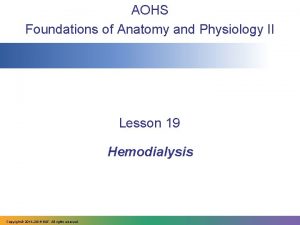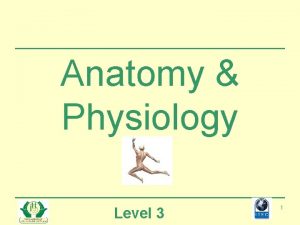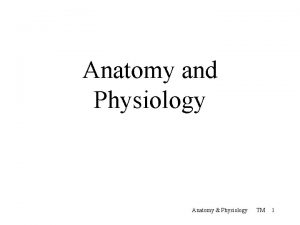AOHS Foundations of Anatomy and Physiology II Lesson


















- Slides: 18

AOHS Foundations of Anatomy and Physiology II Lesson 20 Anatomy and Physiology of the Female Reproductive System Copyright © 2014‒ 2016 NAF. All rights reserved.

By the end of this presentation, you will know: • The organs of the female reproductive system • Changes that occur during puberty • The processes of fertilization and pregnancy • The anatomical and physiological changes that occur during pregnancy • The hormones involved in labor and childbirth • How the process of menopause occurs

The female reproductive system has many tasks • Produce gametes in preparation for fertilization • Gestate and give birth • Feed a newborn How are these tasks different from those of the male reproductive system?

Ovaries are almond-shaped organs located on either side of the pelvic cavity The ovaries of a baby girl contain the precursors to her egg cells. When a girl reaches puberty, her precursor egg cells begin to mature, one each month, in the ovaries. The mature cell is called an oocyte.

After an oocyte matures, it enters the fallopian tube Fallopian tubes aren’t directly connected to the ovaries, but they drape over them in a funnel shape. Fertilization often occurs in the fallopian tube.

The fallopian tubes connect to the uterus The uterus is a hollow, muscular organ in the pelvis. When a fertilized egg cell arrives in the uterus, it attaches itself to the inner wall, where it stays and develops into a fetus.

The cervix is at the base of the uterus The cervix is a cylinder of muscle. The opening at the center of the cervix widens or dilates as a woman is about to give birth. A test called a pap smear is commonly given to check for cervical cancer as a routine part of female health care.

The vagina is a passageway for sperm to enter and an infant being born to exit The environment in the vagina is slightly acidic, inviting some helpful bacteria and discouraging some harmful ones. Why is it important to keep harmful bacteria out of the vagina?

The exterior genitalia, called the vulva, consist of two pairs of labia and the clitoris The labia cover and protect the vagina. Glands near the labia secrete a lubricating fluid. As with the penis, the clitoris responds to stimulation and becomes swollen with blood when the woman is sexually excited.

Reproductive organs affect the position of the bladder and urethra in males and females

The breasts are secondary sex organs that provide nourishing milk after the baby is born Breasts contain lobules that house special milkproducing cells. The lobules develop during puberty, as do protective fatty tissues that surround them. What nutrients would you expect to find in milk?

Pregnancy occurs when a sperm penetrates the cell membrane of an oocyte When a sperm enters the oocyte, the nuclei of the two cells fuse. The fertilized egg cell is called a zygote. Only one sperm can fertilize an egg. How are fraternal (nonidentical) twins conceived?

The embryo travels to the uterus and attaches to the inner uterine wall Once the embryo is implanted in the uterus, a flurry of changes begin in the mother’s body. One important change is that the implanted embryo stimulates the production of a hormone known as h. CG. This is the substance being tested for in a home pregnancy test.

The placenta forms from the uterine wall and produces hormones The amniotic sac forms around the embryo. The placenta forms on one side of the amniotic sac. The placenta allows for the exchange of oxygen and wastes between mother and fetus. What happens when the Rh factor of the mother’s blood is negative and the baby’s is positive?

Before birth, the fetus produces the hormone oxytocin Oxytocin stimulates the placenta to release hormones called prostaglandins. Together, these hormones cause the uterus to contract. Contractions cause the mother’s pituitary to release oxytocin as well, bumping up the strength and frequency of contractions.

Stronger and more frequent uterine contractions stimulate more oxytocin Increasing oxytocin creates a positive feedback cycle that continues to make contractions stronger and more frequent until the baby is born. How is this positive feedback loop different from the negative feedback loops of homeostasis?

Oxytocin also stimulates maternal feelings and feelings of affection Oxytocin initiates the desire of a mother to care for her baby. It also plays a role in the emotional attachments we feel in romantic relationships.

The female reproductive system changes through a woman’s lifetime Women are most fertile in their 20 s. Beginning in their late 30 s or early 40 s, estrogen and progesterone levels begin to fluctuate. Ovulation gradually becomes less frequent, stopping completely around age 45‒ 55.
 Aohs foundations of anatomy and physiology 1
Aohs foundations of anatomy and physiology 1 Aohs foundations of anatomy and physiology 1
Aohs foundations of anatomy and physiology 1 Aohs foundations of anatomy and physiology 1
Aohs foundations of anatomy and physiology 1 Aohs foundations of anatomy and physiology 1
Aohs foundations of anatomy and physiology 1 The speed at which the body consumes energy
The speed at which the body consumes energy Aohs foundations of anatomy and physiology 1
Aohs foundations of anatomy and physiology 1 Aohs health careers exploration
Aohs health careers exploration Upper respiratory tract organs
Upper respiratory tract organs Tattoo anatomy and physiology
Tattoo anatomy and physiology Science olympiad anatomy and physiology
Science olympiad anatomy and physiology External parts of a leaf
External parts of a leaf Anatomy and physiology of bone
Anatomy and physiology of bone Anatomy and physiology of peptic ulcer ppt
Anatomy and physiology of peptic ulcer ppt Liver anatomy and physiology
Liver anatomy and physiology Epigastric region
Epigastric region Difference between anatomy and physiology
Difference between anatomy and physiology Blood in anatomy and physiology
Blood in anatomy and physiology Chapter 14 anatomy and physiology
Chapter 14 anatomy and physiology 3 layers of muscle
3 layers of muscle
































